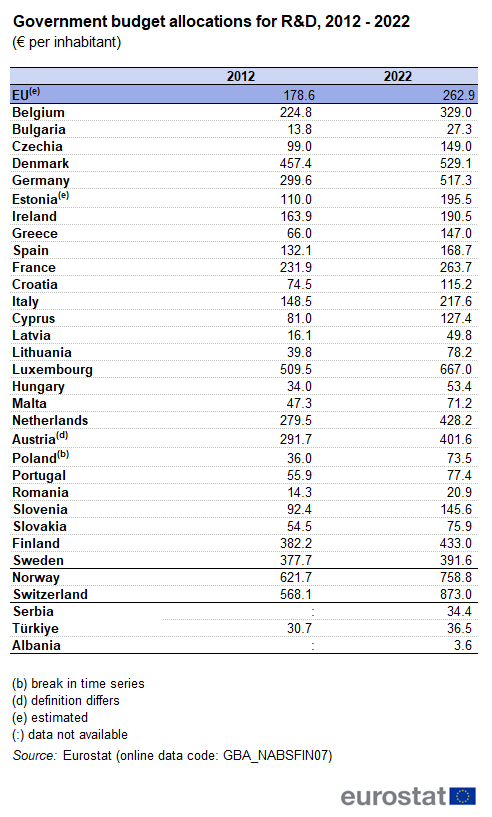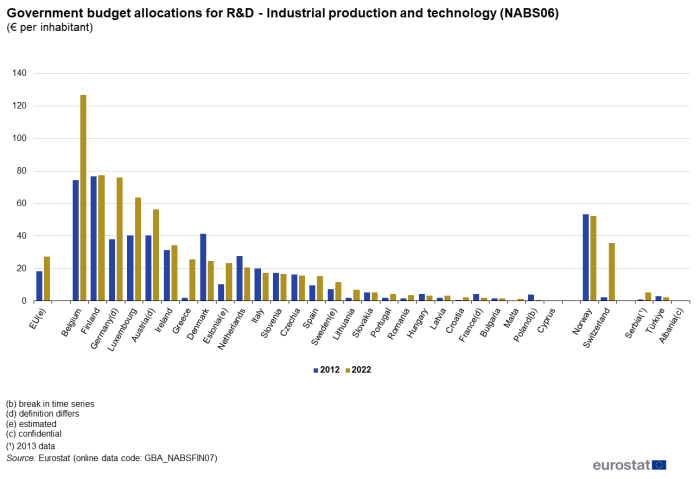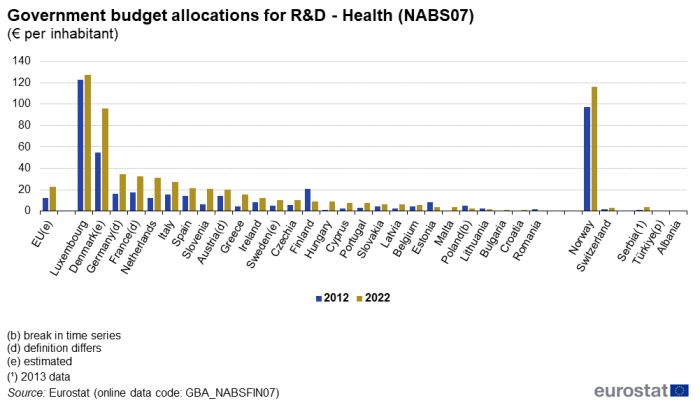Government budget allocations for R&D (GBARD)
Data extracted in January 2024
Planned article update: 31 July 2024
Highlights
In 2022, the final total government budget allocations for R&D (GBARD) across the EU stood at €117 424 million, equivalent to 0.74% of GDP.
The final government budget allocations for R&D at EU level stood at €262.9 per person in 2022, a 47.2% increase compared with 2012 (€178.6 per person).
Government budget allocations for research and development, 2012 - 2022
Statistics on Government Budget Allocations for R&D (GBARD) in the European Union provide users with data measuring government support to research and development (R&D) activities, and thereby inform about the priority governments give to different public R&D funding activities. GBARD covers not only government-financed R&D performed in government establishments but also government-financed R&D in the other three national sectors (business enterprise, private non-profit, higher education) as well as to the rest of the world sector. The socioeconomic objective "General advancement of knowledge", regardless of the sources of funds, represents more than 50 % of GBARD. The data are compiled by national authorities using data collected from public budgets. This type of fund-based approach for reporting R&D involves identifying all the budget items that may support R&D activities and measuring or estimating their R&D content.
Research and Development (R&D) is central to many European and national level policies that aim to increase the competitiveness of the EU's economies and the welfare of its citizens and is a cross cutting subject relevant to the political priorities of the European Commission.
Full article
Total GBARD across the EU
In 2022, the total final government budget allocations for R&D (GBARD) across the EU stood at €117 424 million (Table 1), equivalent to 0.74 % of GDP (Table 2).

Source: Eurostat (GBA_NABSFIN07)

Source: Eurostat (GBA_NABSFIN07)
The final government budget allocations for R&D per person at EU level stood at €262.9 in 2022 (Table 3). The highest allocations per person were recorded in Luxembourg (€667.0), followed at a distance by Denmark (€529.1) and Germany (€517.3). On the other hand, the EU countries with the lowest R&D budget allocations per person were Hungary (€53.4), Latvia (€49.8), Bulgaria (€27.3) and Romania (€20.9).

Source: Eurostat (GBA_NABSFIN07)
Evolution of GBARD in the EU during the 2012 - 2022 decade
GBARD figures for the 2012 - 2022 decade show an increase at EU level from €78 699 million to €117 424 million (Table 1), an increase of 49.2 %. GBARD almost tripled in Latvia (from €32.8 million to €93.4 million) and it more than doubled in Greece (from €731.9 million to €1 537.5 million) and it almost doubled in Poland (from €1 370.1 million to €2 768.1 million), Malta (from €19.7 million to €37.1 million) and Bulgaria (from €101 million to €187.0 million). The total allocations further increased by more than 50 % in ten more EU Member States, with an increase of more than 75 % in Lithuania (+83.4 %), Germany (+78.9 %) and Estonia (+78.5 %) At the other end of the scale, with low GBARD increases during the 2012 - 2022 decade, were France (18.3 %), Finland (16.4 %) and Sweden (14.3 %).
GBARD figures as a percentage of GDP show an increase at EU level for the 2012 - 2022 decade (Figure 1), from 0.69 % of GDP in 2012 to 0.74 % of GDP in 2022. The GBARD as a percentage of GDP recorded an increase in ten EU Member States, notably Greece (+0.35 percentage points (pp)), Germany (+0.23 pp), Italy (+0.12 pp), Latvia (+0.9 pp), the Netherlands and Poland (both with +0.07 pp). GBARD as a percentage of GDP recorded a negative growth for the rest of the 17 EU Member States during the decade 2012 - 2022, with five Member States recording a decrease of only 0.1 pp or 0.2 pp and with Ireland (-0.24 pp), Denmark (-0.18 pp), Finland (-0.13 pp) and Sweden (-0.10 pp) recording the most declines.

Source: Eurostat (GBA_NABSFIN07)
As the changes in GBARD expressed as a percentage of the GDP can reflect a change in the GDP, it is useful to look at the changes in the allocations per capita as well. The government budget allocations for R&D per person increased by 47.2 % between 2012 and 2022 in the EU, from €178.6 to €262.9 per person. Over the last decade, the largest percentage increases in government budget allocations for R&D per person were recorded in Latvia (+209.3 %, from €16.1 in 2012 to €49.8 per person in 2022), Greece (+122.7 %, from €66 to €147 per person), Poland (+104.2 %, from €36 in 2012 to €73.5 per person in 2022), Bulgaria (+97.8 %, from €13.8 to €27.3 per person) and Lithuania (+96.5 %, from €39.8 to €78.2 per person). It should be noted as well, that changes in GBARD per capita may reflect population changes of the countries as well.
GBARD by socioeconomic objectives (NABS 2007)
GBARD data are broken down by socioeconomic objectives in accordance with the nomenclature for the analysis and comparison of scientific programmes and budgets (NABS 2007). Figure 2 presents the 2022 distribution of GBARD by socioeconomic objective, where the most representative objectives were:
- General advancement of knowledge: R&D financed from general university funds (GUF): 35.3 %;
- General advancement of knowledge: R&D financed from other sources than GUF: 16.8 %;
- Industrial production and technology: 10.4 %;
- Health: 8.5 %;
- Exploration and exploitation of space: 5.9 %.

Source: Eurostat (GBA_NABSFIN07)
Figure 3 shows a 48 % increase in the EU spending per inhabitant in the "Industrial production and technology" socioeconomic objective between 2012 and 2022. The EU countries that spent the most per inhabitant in this objective in 2022 were Belgium, Finland, Germany, Luxembourg and Austria (more than double the EU average). Regarding the socioeconomic objective "Health", a significant increase (+82 %) in the spending per inhabitant in the period 2012 to 2022 in the EU can be seen in Figure 4. The highest increases were recorded in Malta, Hungary, Cyprus, Greece, Slovenia and Latvia, where the large relative increase reflects a small absolute increase of a low absolute 2012 figure. Among the countries where spending per inhabitant is already significantly higher than the EU average, the increase was substantial in the Netherlands (+149 %), Germany (+117 %) and France (+90 %).

Source: Eurostat (GBA_NABSFIN07)

Source: Eurostat (GBA_NABSFIN07)
Source data for tables and graphs
Data sources
Since the beginning of 2021, the collection of R&D statistics is based on Commission Implementing Regulation (EU) No 1197/2020 of 30 July 2020. Statistics on science, technology and innovation were collected until the end of 2020 based on Commission Implementing Regulation (EU) No 995/2012 concerning the production and development of Community statistics on science and technology. More information on the changes and new data requirements introduced by the European Business Statistics regulation can be found in the Statistics Explained article on European Business Statistics.
GBARD data are compiled using the methodology laid out in the Guidelines for collecting and reporting data on research and experimental development - Frascati Manual, OECD, 2015: Guidelines for Collecting and Reporting Data on Research and Experimental Development which is the internationally recognised standard methodology for collecting R&D statistics. Eurostat's guidelines on methodology for compiling the GBARD data is the European Business Statistics Methodological Manual for R&D Statistics.
Eurostat's free online reference database contains national data from 1980 onwards, though the data availability differs according to country. European aggregates are available from 2000 onwards. GBARD data are provided to Eurostat directly by the national statistical authorities of Member States of the European Union and the EFTA, candidate and potential candidate countries. Data for Japan, the United States and South Korea are extracted from the OECD database.
GBARD covers not only government-financed R&D performed in government establishments but also government-financed R&D in the other three national sectors: business enterprise (BES), private non-profit (PNP), higher education (HES) as well as the rest of the world, including international organisations (§ 12.16, Frascati Manual, OECD 2015). Government budget allocations for R&D (GBARD) are all provisions allocated to R&D in central (federal) government, regional (state) and local (municipal) government. They therefore refer to budget provisions, not to actual expenditure. Local government budget funds may not be included if their contribution is not significant or if the data cannot be collected.
GBARD data cover all public budget spending related to R&D and are linked to policy issues by means of a classification by "objectives" or "goals" (NABS 2007). Programmes are allocated between socioeconomic objectives, on the basis of intentions at the time the funds are committed and not the actual content of the projects concerned.
Context
Statistics on Government Budget Allocations for R&D (GBARD) are an important component of research and development (R&D) statistics within the European Union (EU).
Research and Development (R&D) is central to many European and national level policies that aim to increase the competitiveness of the EU's economies and the welfare of its citizens. R&D was put forward as a driving theme in the Political Guidelines for the current European Commission 2019 to 2024.
One of the key aims of the EU during the last couple of decades has been to encourage increasing levels of research investment, in order to provide a stimulus to the EU's competitiveness. In May 2021, the European Commission adopted a Communication on a global approach to research and innovation - Europe's global approach to cooperation in research and innovation: strategic, open, and reciprocal. This Communication underlines the EU's desire to play a leading role in supporting international research and innovation partnerships, while delivering innovative solutions that support green and digital solutions in line with the sustainable development goals. It engages the EU to promote resilience, prosperity, competitiveness, economic and social well-being.
Direct access to
See also
Main tables
- Government budget allocations for R&D (GBARD) (t_gba)
Database
- Government budget allocations for R&D (GBARD) (gba)
Dedicated section
Publications
Methodology
Legislation
Since the beginning of 2021, the collection of R&D statistics is based on Commission Implementing Regulation (EU) No 1197/2020 of 30 July 2020. Previously, these data were collected under Regulation (EU) No 995/2012 concerning the production and development of Community statistics on science and technology.